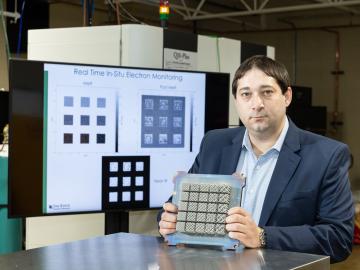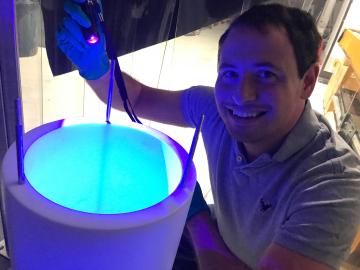
Filter News
Area of Research
- (-) Energy Science (41)
- (-) Fusion Energy (3)
- (-) Materials (83)
- Advanced Manufacturing (4)
- Biology and Environment (30)
- Computational Biology (1)
- Computational Engineering (2)
- Computer Science (1)
- Fusion and Fission (5)
- Isotope Development and Production (1)
- Isotopes (19)
- Materials Characterization (1)
- Materials for Computing (14)
- Materials Under Extremes (1)
- Mathematics (1)
- National Security (4)
- Neutron Science (71)
- Nuclear Science and Technology (7)
- Supercomputing (35)
- Transportation Systems (1)
News Type
News Topics
- (-) Biomedical (7)
- (-) Clean Water (6)
- (-) Frontier (3)
- (-) Isotopes (7)
- (-) Materials Science (69)
- (-) Mercury (3)
- (-) Neutron Science (30)
- 3-D Printing/Advanced Manufacturing (70)
- Advanced Reactors (10)
- Artificial Intelligence (7)
- Big Data (3)
- Bioenergy (22)
- Biology (9)
- Biotechnology (3)
- Buildings (27)
- Chemical Sciences (26)
- Composites (15)
- Computer Science (26)
- Coronavirus (11)
- Critical Materials (19)
- Cybersecurity (6)
- Energy Storage (69)
- Environment (40)
- Exascale Computing (2)
- Fossil Energy (1)
- Fusion (12)
- Grid (30)
- High-Performance Computing (5)
- Hydropower (2)
- ITER (1)
- Machine Learning (7)
- Materials (71)
- Mathematics (2)
- Microscopy (22)
- Molten Salt (3)
- Nanotechnology (34)
- National Security (6)
- Nuclear Energy (15)
- Partnerships (11)
- Physics (21)
- Polymers (18)
- Quantum Computing (3)
- Quantum Science (11)
- Security (5)
- Simulation (2)
- Space Exploration (3)
- Statistics (1)
- Summit (5)
- Transportation (55)
Media Contacts

Oak Ridge National Laboratory researchers have demonstrated that a new class of superalloys made of cobalt and nickel remains crack-free and defect-resistant in extreme heat, making them conducive for use in metal-based 3D printing applications.

Three technologies developed by ORNL researchers have won National Technology Transfer Awards from the Federal Laboratory Consortium. One of the awards went to a team that adapted melt-blowing capabilities at DOE’s Carbon Fiber Technology Facility to enable the production of filter material for N95 masks in the fight against COVID-19.

Growing up in the heart of the American automobile industry near Detroit, Oak Ridge National Laboratory materials scientist Mike Kirka was no stranger to manufacturing.

The COHERENT particle physics experiment at the Department of Energy’s Oak Ridge National Laboratory has firmly established the existence of a new kind of neutrino interaction.


Marcel Demarteau is director of the Physics Division at the Department of Energy’s Oak Ridge National Laboratory. For topics from nuclear structure to astrophysics, he shapes ORNL’s physics research agenda.

Six scientists at the Department of Energy’s Oak Ridge National Laboratory were named Battelle Distinguished Inventors, in recognition of obtaining 14 or more patents during their careers at the lab.

Six ORNL scientists have been elected as fellows to the American Association for the Advancement of Science, or AAAS.

Seven ORNL scientists have been named among the 2020 Highly Cited Researchers list, according to Clarivate, a data analytics firm that specializes in scientific and academic research.

An international multi-institution team of scientists has synthesized graphene nanoribbons – ultrathin strips of carbon atoms – on a titanium dioxide surface using an atomically precise method that removes a barrier for custom-designed carbon


